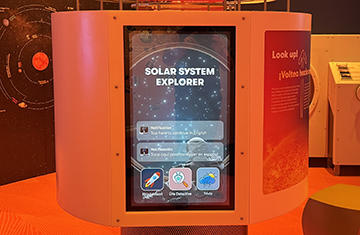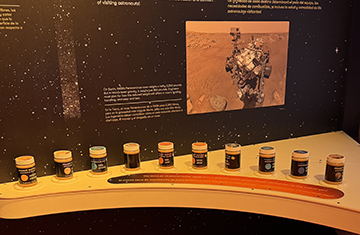
Exploring Space:
The completely reimagined Exploring Space gallery will take you on a journey through the cosmos, offering a look at our universe and humanity’s future in space. Through Earth-based astronomy, human exploration, and deep-space observation, the gallery expands our understanding of the universe and prepares us for distant missions. Visitors become part of the adventure with hands-on activities, multimedia, artifacts, and personal stories, experiencing liftoff, traveling through the solar system, exploring deep space, and stepping into a space-station to discover the challenges and excitement of life in space.
THE GALAXY IS OPEN TO EXPLORE.
Supported by
The Barnes Group Foundation
Ensign-Bickford Aerospace & Defense
This project was made possible in part by the Institute of Museum and Library Services. Este proyecto ha sido posible en parte por el Instituto de Servicios de Museos y Bibliotecas.
Generous Support from the State of Connecticut Department of Economic & Community Development
OUR SOLAR NEIGHBORHOOD
Our solar system is much more than the Sun and its eight planets—it's a vast, dynamic "neighborhood." Solar flares erupt from the Sun, sending cosmic radiation through space, while dwarf planets travel among uncharted asteroids. Nearby planets host hundreds of moons, featuring erupting volcanoes, rivers of methane, and vast underground oceans that might even harbor simple life. By studying our local space, we gain insight into the broader galaxy. How stars and planets form, interact, and emit energy here applies just as well a million light years away.

Solar System Explorer
Sit at one of four oversized phone-shaped screens beneath a projection of the Sun and explore the solar system through familiar “apps.” Check the weather on Venus, get directions to Mars, or swipe through Solr to find your planetary match. Each “app” offers a fun, quiz-like experience with simple, playful questions in a familiar interface.

Sun Projection
Above the Solar System Explorer, a large, dynamic projection of the Sun hangs from the ceiling. Built from NASA’s Solar Dynamics Observatory data, its fiery surface roils, with solar flares snapping across its face. Like the Sun itself, this vivid visualization serves as the centerpiece of the “Our Solar Neighborhood” gallery.

Gravity Jump
Choose a life-sized, space-suited avatar and watch it appear on different planetary surfaces projected on the wall. When you jump, the avatar mirrors your movements, with varying results depending on the planet. On Venus, your jump is similar to Earth’s, but on a small asteroid, your avatar might soar to the gallery’s rafters.

Weight, Don't Tell Me
This interactive lets visitors feel how weight varies by location. Lifting a can of soup on Jupiter is much harder than on Mercury! Beyond soup, it illustrates how landers and spacecraft must account for gravity differences—lower gravity can enable safer landings, save fuel, and increase cargo capacity.

Orbit Table
This interactive “air hockey” table demonstrates how sideways motion, combined with gravity, keeps an object in orbit. Experiment to find the “sweet spot” for a stable orbit—how much force does it take?

Earth Observer
From a space station lab (via a monitor and console powered by Google Earth), look back at Earth with a perspective only possible from space. Use this tool to view climate, weather, and land-cover data, observe human impact, explore remote areas, or even locate your own home—all from the comfort of the control console.

Artificial Gravity
This exhibit illustrates the long-term effects of weightlessness and demonstrates how centrifugal force might counteract them. By spinning a model of spacecraft living quarters, you can watch astronaut figures settle against the walls—even upside down! Similar strategies could help keep astronauts grounded in future space missions.

Mars Magnet Wall
A large magnet wall with fun, stylized illustrations of a future Martian colony invite imaginative play for all ages. Visitors can arrange movable vehicles and buildings across the wall, setting up everything a colony might need. What will your Martian town look like?
EXPLORING THE UNIVERSE:
The Sun is just one of hundreds of billions of stars in our Milky Way galaxy, which is itself one of countless galaxies in a universe possibly 93 billion light years across. To study these distant realms, we use specialized tools on Earth and in space to analyze light and energy from faraway objects, applying knowledge from our solar system to stars and planets beyond. Each discovery deepens our understanding—from potential signs of life to the forces shaping mass and energy, to the origins of the universe.

Constellation Stations
A field of glowing "stars" spans the exhibition’s dark ceiling. From most angles, the stars appear random, but from certain viewpoints, familiar constellations emerge. At each Constellation Station, a pivoting scope helps locate specific constellations, aligning an illustration with the correct stars. Different stations feature constellations visible only in the northern or southern hemispheres.

Gathering Light
Compare side-by-side images of space phenomena captured by the Hubble and James Webb telescopes. While both are remarkable tools, Webb's images are brighter, clearer, and reveal details beyond Hubble’s reach.

Space Pods
Strap in with a companion and get ready for a journey through space. Start with real launch footage, then choose from short multimedia experiences featuring stunning galactic sights. Options include a peaceful interstellar tour with ambient sounds or a thrilling Mars landing.

Seeing in a New Light
Use a set of simple tools to uncover hidden messages and designs on seemingly blank tiles, simulating real methods for observing invisible energy and forces in space. Infrared light, UV fluorescence, and a magnetic field detector reveal information invisible to the naked eye.

Spacesuit Photo
Alone or with a friend, place your face in the cutout behind the domed helmets of two spacesuits. Smile for the camera and snap a photo of yourself exploring the surface of Mars.

Spacesuit Fashion Show
A digital "fashion show" showcases spacesuit technology, past, present, and future. From Gemini-era suits to today’s Extravehicular Mobility Units and prototypes for future Moon or Mars missions. Each suit includes highlights of special features, astronaut stories, and cross-sections showing the layers that protect explorers in extreme environments.

Nose Cone & Frangible Joint
The battered nose cone of the suborbital rocket that carried the ashes of James Doohan—Star Trek’s “Mr. Scott”—into space is signed by his family, friends, and colleagues. Nearby, a model Vulcan rocket is displayed alongside a real frangible joint, made by Connecticut’s Ensign-Bickford Aerospace & Defense. This joint enables rocket stages to separate with controlled explosions during launches, a technology still used in many space missions today.
THE FUTURE IN SPACE:
Wherever we travel in space, human ingenuity will lead the way—planning missions, building equipment, and solving problems. Our needs will remain the same: sustenance, protection, and companionship. Thriving in space will require science, engineering, and a commitment to our shared humanity.

Powering Your Spacecraft
Monitor the screens and manage the controls to maintain power on an orbital space station with limited batteries and solar arrays. As the station enters a planet's shadow, carefully control which systems use power. Can you keep life support running through the orbital "night" on battery power alone?

Vacuum Chamber Glove Box
A spacesuit glove is mounted in a clear chamber with simple manual tasks—until the air is pumped out. As pressure drops, the glove stiffens, making fine tasks much harder. Designing suits that work better in a vacuum is an ongoing challenge for NASA.

Sleeping in Space
Explore a simulated astronaut berth, complete with personal tools, toys, and mementos, and discover what it’s like to sleep in the highest "top bunk" imaginable.

Space Toilet
Discover how real astronauts train to use the toilet in microgravity and explore a digital display on the surprising history of space bathrooms. Snap a fun selfie in a life-size model space toilet.

Space Aptitude Quiz
At a control terminal in the exhibit’s “space station,” take a quick quiz to see how your skills could fit into a space mission—whether in a rocket, a lab, or at a desk. This lighthearted quiz introduces various space careers. Once you find your match, meet someone from Connecticut in that field and hear their story.

Eating in Space
Explore real NASA space foods “floating” in a clear display to see what astronauts eat and how months of rations are packed efficiently. Digital graphics share surprising facts and stories about eating in space, along with images of astronauts preparing and enjoying meals in orbit.

Space Portals
Look out the "window" to see imagery from orbital telescopes and spacecraft, capturing Earth’s curve, brilliant sunrises, lightning storms, and glowing city lights at night, alongside telescopic views of deep space objects like nebulae, stars, and distant galaxies.